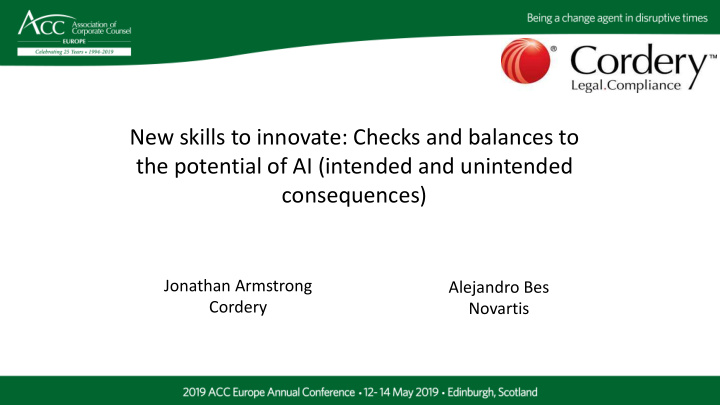



New skills to innovate: Checks and balances to Click to add title the potential of AI (intended and unintended consequences) Click to add subtitle Jonathan Armstrong Alejandro Bes Cordery Novartis
Introduction • What is AI? • Machine Learning vs. AI • GIGO (e.g. ICO focus on inputs & outputs) 2
GIGO “At present, AI is far more ‘artificial’ than it is ‘intelligent’” Gregory Stern, Global Integration Counsel, Chubb 3
A quick case study... 4
Click to add title New skills to innovate: Checks and balances to the potential of AI (intended and unintended consequences) Click to add subtitle Alejandro Bes 5
Areas of Interest • Practical Principles • Industry applications • Risk & Issues • Mitigating measures • How training influences output • What worked – Industry applications 6
Pixabay licensed – Free for commercial use 7
Industry applications “The malicious use of AI will impact how we construct and manage our digital infrastructure as well as how we design and distribute AI systems. “ Miles Brundage et al. The Malicious Use of Artificial Intelligence: Forecasting, Prevention, and Mitigation. arXiv:1802.07228 8
General ethical principles on AI systems • 1. Human • 2. Well-being • 3. Data Agency • 4. Effectiveness • 5. Transparency • 6. Accountability • 7. Awareness of Misuse • 8. Competence Source: IEEE , General Principles of Ethically Aligned Design • 9
Risks & Issues • Data Protection & Privacy – improper use of data • Safety & Security – Reliability of outputs, safe and secure through operational lifetime • Openess – Fights against the black box effect and failure transparency • Bias • Voluntary vs. Involuntary – Incomplete data • Problems derived from the interpretation and inferences about outputs • Anchoring effect • Decision making – Shift of power about the ultimate decision maker 10
How training influences output XKCD. CC 2.5 License https://xkcd.com/1838/ 13
In Industry y examples es • Health and well being – smarter and more targeted treatments, improved analysis and diagnosis and patient support • Workplace recruitment – targeted and accurate selection of candidates, workplace support and improved underrepresented population hiring practices • Finance – Improved financing processes and customer relationship • Transportation – Improved processes and systems. Transition from semi autonomous to fully autonomous AI driving. 14
Lifecycle effort Ethics Guidelines for Trustworthy AI, High Level Expert Group on AI 15
Suggested readings • Ethically Aligned Design, First Edition • The IEEE Global Initiative on Ethics of Autonomous and Intelligent Systems • The Malicious Use of Artificial Intelligence: Forecasting, Prevention, and Mitigation • Brundage et al. arXiv:1802.07228 • Building Trust in Human Centric AI • https://ec.europa.eu/futurium/en/ai-alliance-consultation/guidelines#Top 16
Applications • Be clear about AI vs. Machine Learning • Don’t bake in failure • Be self-analytical • “Train your dragon wisely” • Devote appropriate time and seniority 17
Risks • Psychology - Man vs. Machine • Big Data vs. Data Protection • Data Ubiquity vs. Data Security 18
GDPR 6 Principles 1. Lawfulness, fairness and transparency. 2. Purpose limitation – make sure you only collect data for specified, explicit and legitimate purposes. 3. Data minimisation – make sure your use of data is adequate, relevant and limited to what is necessary. 4. Accuracy – make sure your data is accurate and, where necessary, kept up to date. 5. Storage limitation – don’t keep data for longer than necessary. 6. Integrity and confidentiality – make sure data is processed in a manner that ensures the appropriate security of personal data, including protection against unauthorised or unlawful processing and against accidental loss, destruction or damage. Make sure appropriate TOMs are in place. 19
Mitigation • DPIA / detailed risk analysis (mandatory under GDPR) • Hambach Declaration - – include non-GDPR legal risks e.g. discrimination • UX and psychology • Proper legal agreements (including 6 principles, ground truth assessment etc.) • Know your data – the data you created + the data your tool creates • Have a proper DSR strategy (including SARs, RTBF, rectification) 20
Resources • GDPR FAQs – http://bit.ly/eugdprfaq • Breach Navigator - http://bit.ly/breachnav • ICO May 2019 Guidance - http://bit.ly/2GXUV73 • Judge’s task force - http://bit.ly/2JdHYII • Singapore Infocomm Media Development Authority framework - http://bit.ly/2GTdskI 21
Contact Jonathan Armstrong jonathan.armstrong@corderycompliance.com +44 (0) 20 7118 2700 Twitter:@armstrongjp 22
Questions and Answer Session Jonathan Armstrong Cordery jonathan.armstrong@corderycompliance.com +44(0) 20 7075 1784 Alejandro Bes Novartis alejandro.bes@novartis.com 23
Recommend
More recommend